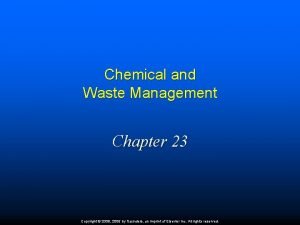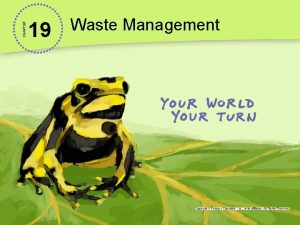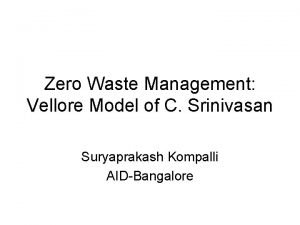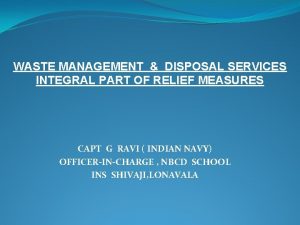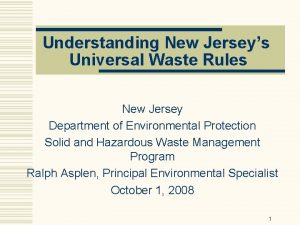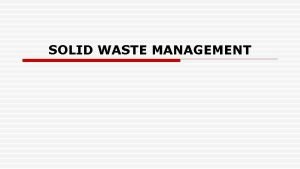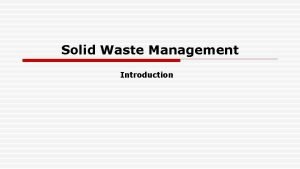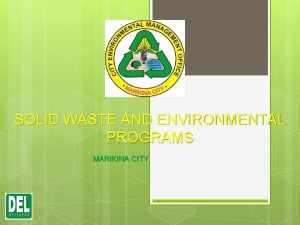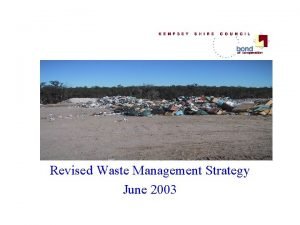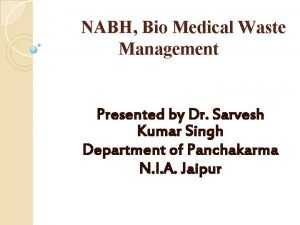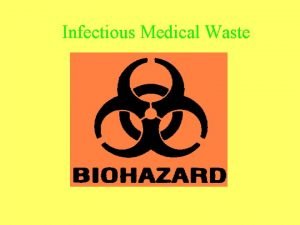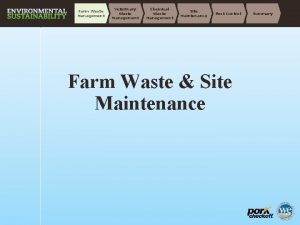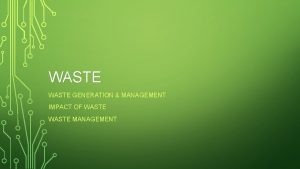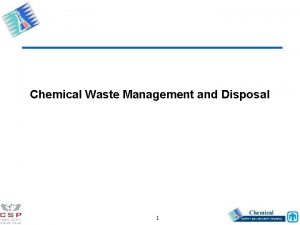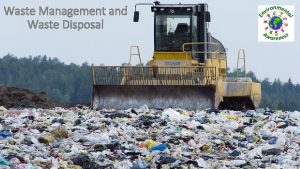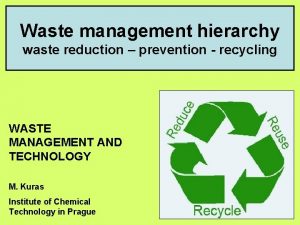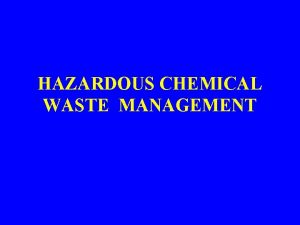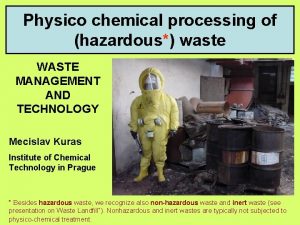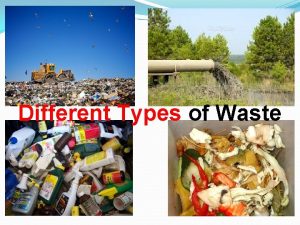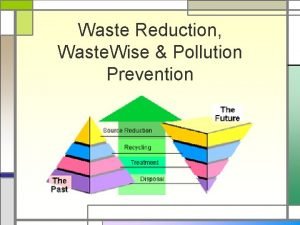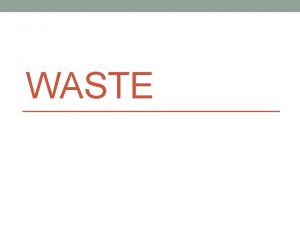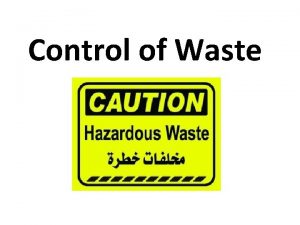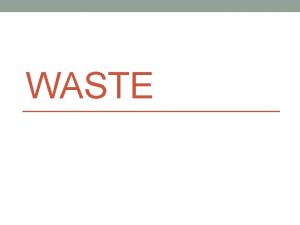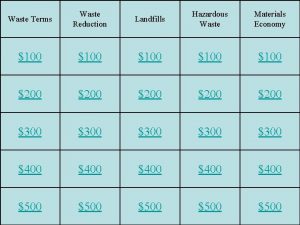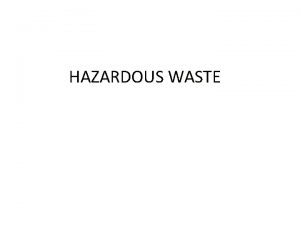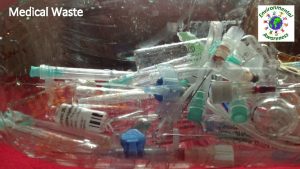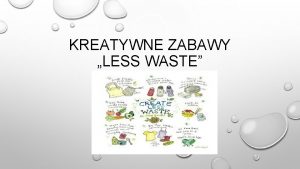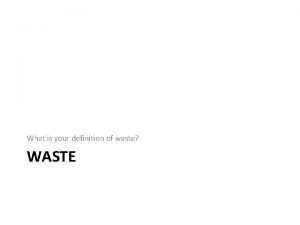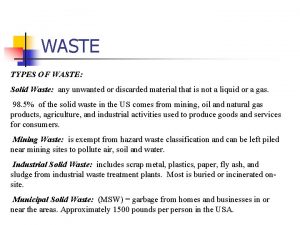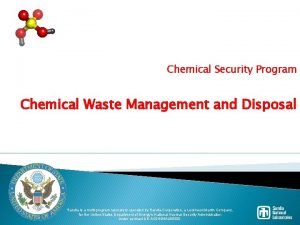Chemical and Waste Management Chapter 23 Copyright 2009



































- Slides: 35

Chemical and Waste Management Chapter 23 Copyright © 2009, 2006 by Saunders, an imprint of Elsevier Inc. All rights reserved.

Chapter 23 Lesson 23. 1 Copyright © 2009, 2006 by Saunders, an imprint of Elsevier Inc. All rights reserved.

Learning Objectives Pronounce, define, and spell the Key Terms. Describe the potential long-term and shortterm effects of exposure to chemicals. Describe three common routes of chemical exposure. (Cont’d) Copyright © 2009, 2006 by Saunders, an imprint of Elsevier Inc. All rights reserved.

Learning Objectives (Cont’d) Describe the difference between chronic and acute chemical exposure. Identify four methods of personal protection against chemical exposure. Describe in general how chemicals should be stored. Copyright © 2009, 2006 by Saunders, an imprint of Elsevier Inc. All rights reserved.

Introduction In the day-to-day practice of dentistry, the dental assistant is exposed to a wide variety of chemicals used for treatment procedures, cleaning of instruments and surfaces, disinfection and sterilization, laboratory procedures, and x-ray processing. The heart, kidney, liver, and lung tissues can be damaged by these chemicals. Results of exposure range from short-term discomfort (e. g. , burns, rashes) to life-threatening conditions (e. g. , cancer, sterility, organ failure). (Cont’d) Copyright © 2009, 2006 by Saunders, an imprint of Elsevier Inc. All rights reserved.

Introduction (Cont’d) For all of the chemicals used in the dental office, it is important for a dental assistant to understand: Ø Ø Ø Proper use Proper storage Proper handling Proper cleanup of spills Proper disposal methods Copyright © 2009, 2006 by Saunders, an imprint of Elsevier Inc. All rights reserved.

Hazardous Chemicals A hazardous chemical is defined as any chemical that has been shown to present either a physical or health hazard. A hazardous chemical is any substance that: Can catch fire Ø Can react or explode when mixed with other substances Ø Is corrosive Ø Is toxic Ø Copyright © 2009, 2006 by Saunders, an imprint of Elsevier Inc. All rights reserved.

Fig. 23 -1 Chemical-hazard warning labels. (From Stepp CA, Woods MA: Laboratory procedures for medical office personnel, Philadelphia, 1998, Saunders. ) Copyright © 2009, 2006 by Saunders, an imprint of Elsevier Inc. All rights reserved.

Primary Methods of Chemical Exposure Gases, vapors, and dusts of chemicals can cause direct damage to the lungs. Some chemicals are absorbed through the skin. Eating in an area in which chemicals are used or eating with hands contaminated with chemicals is a common way of ingesting harmful chemicals. Copyright © 2009, 2006 by Saunders, an imprint of Elsevier Inc. All rights reserved.

Types of Chemical Toxicity Acute chemical toxicity results from a high level of exposure over a short period. Such exposure is frequently caused by a chemical spill, in which exposure is sudden and a large amount of the chemical in question may be involved. Chronic chemical toxicity results from many repeated exposures, generally to lower levels, over a much longer time—months or even years. Copyright © 2009, 2006 by Saunders, an imprint of Elsevier Inc. All rights reserved.

Personal Chemical Protection Hand protection: When using chemical disinfectants, wear a utility-type glove made from a chemicalresistant material such as natural rubber, neoprene, or industrial-grade nitrile. Eye protection: Protect the eyes from fumes and splashes while pouring chemicals, such as processing solutions for x-rays, ultrasonic solutions, disinfectants, and sterilants. Protective clothing: Wear a rubber or neoprene apron when mixing or pouring a chemical. Inhalation protection: Face masks should be fluid-repellent and provide respiratory protection. Copyright © 2009, 2006 by Saunders, an imprint of Elsevier Inc. All rights reserved.

Fig. 23 -2 Clean-room nitrile gloves provide protection and dexterity in the handling of chemicals. (Courtesy of Lab Safety Supply, Janesville, Wis. ) Copyright © 2009, 2006 by Saunders, an imprint of Elsevier Inc. All rights reserved.

Fig. 23 -3 Dental assistant wearing chemical goggles. Copyright © 2009, 2006 by Saunders, an imprint of Elsevier Inc. All rights reserved.

Fig. 23 -4 This disposable respirator has a tapered angle to fit facial contours around the nose and chin to protect against dusts and chemical mists. (Courtesy of Lab Safety Supply, Janesville, Wis. ) Copyright © 2009, 2006 by Saunders, an imprint of Elsevier Inc. All rights reserved.

Control of Chemical Spills Accidents and spills should not be common occurrences. Planning and practice in dealing with such spills should minimize employee exposure to harmful chemicals. Refer to the material-safety data sheet (MSDS) for the specific product for accurate information on how to manage spills. Copyright © 2009, 2006 by Saunders, an imprint of Elsevier Inc. All rights reserved.

Mercury-Spill Kits Mercury-spill kits should be available in all dental offices in which amalgam is used. Exposure to even small amounts of mercury is very hazardous to the health of dental personnel. Mercury can be absorbed through the skin or through the inhalation of mercury vapors. Copyright © 2009, 2006 by Saunders, an imprint of Elsevier Inc. All rights reserved.

Fig. 23 -5 Mercury-spill kit. (Courtesy of Lab Safety Supply, Janesville, Wis. ) Copyright © 2009, 2006 by Saunders, an imprint of Elsevier Inc. All rights reserved.

Eye Wash Stations Occupational Safety and Health Administration (OSHA) regulations require an eyewash unit in every place of employment in which chemicals are used. A wide variety of styles are available. When turned on, the eyewash unit will irrigate the eyes with the soft, wide flow of water necessary to bathe away contaminants without causing additional damage. Employees must be trained in the proper use of the eyewash station, and the unit should be inspected every 3 months to ensure that it is functional. Copyright © 2009, 2006 by Saunders, an imprint of Elsevier Inc. All rights reserved.

Fig. 23 -6 A, Countertop eye and eye/face washes provide water to the face and eyes to gently wash away contaminants. (Courtesy of Lab Safety Supply, Janesville, Wis. ) Copyright © 2009, 2006 by Saunders, an imprint of Elsevier Inc. All rights reserved.

Fig. 23 -6 B, A wall-mounted style of eyewash station with a card attached on which to record inspection dates. Copyright © 2009, 2006 by Saunders, an imprint of Elsevier Inc. All rights reserved.

Ventilation Good ventilation is a necessity when dealing with any type of chemical. Many dental offices are equipped with special exhaust systems in the laboratory and sterilization and darkroom areas for fumes and dust. Radiographic processing chemicals can cause contact dermatitis and irritation of the eyes, nose, throat, and respiratory system because of vapors and fine particles of chemicals. Copyright © 2009, 2006 by Saunders, an imprint of Elsevier Inc. All rights reserved.

Storing Chemicals All dental materials contain chemicals, and the chemical components in some are more hazardous than others. When changes in the chemical composition of materials occur, the product may no longer retain its effectiveness. A basic safe policy is to store dental medications and chemicals in a dry, cool, dark place where they are not exposed to direct sunlight. The manufacturer’s instructions for storage can be found on the MSDS and should be followed. Copyright © 2009, 2006 by Saunders, an imprint of Elsevier Inc. All rights reserved.

Disposal of Chemicals Empty containers may hold residues that can burn or explode. Never fill an empty container with another substance, because a dangerous chemical reaction could occur. Follow the label and the MSDS for guidance in disposing of empty containers. Copyright © 2009, 2006 by Saunders, an imprint of Elsevier Inc. All rights reserved.

Types of Hazardous Waste Ignitable waste is flammable or combustible. Corrosive waste is either highly acidic or basic with a p. H less than 2. 0 or greater than 12. 5, respectively (water has a p. H of 7. 0). Reactive waste is chemically unstable or explosive, reacts violently with water, or is capable of giving off toxic fumes when mixed with water. Toxic waste contains arsenic, barium, chromium, mercury, lead, silver, or certain pesticides. These types of hazardous waste are listed by the EPA. Copyright © 2009, 2006 by Saunders, an imprint of Elsevier Inc. All rights reserved.

Chapter 23 Lesson 23. 2 Copyright © 2009, 2006 by Saunders, an imprint of Elsevier Inc. All rights reserved.

Learning Objectives Explain the purpose of the OSHA Hazard Communication Standard. Explain the recordkeeping requirements of the Hazard Communication Program. Describe the components of a hazardcommunication program. Explain the purpose of a MSDS. (Cont’d) Copyright © 2009, 2006 by Saunders, an imprint of Elsevier Inc. All rights reserved.

Learning Objectives (Cont’d) Create a label for a secondary container. Identify types of regulated waste generated in a dental office. Identify types of toxic waste generated in a dental office. Describe how to package regulated waste for transport. Copyright © 2009, 2006 by Saunders, an imprint of Elsevier Inc. All rights reserved.

OSHA Hazard Communication Standard OSHA issued the Hazard Communication Standard because employees have the right to know the identity and hazards of chemicals that they use in the workplace. The Hazard Communication Standard is also known as the Employee Right-to-Know Law. It requires employers to implement a hazard communication program. Copyright © 2009, 2006 by Saunders, an imprint of Elsevier Inc. All rights reserved.

Hazard-Communication Program Written program Chemical inventory MSDS Labeling of containers Employee training Copyright © 2009, 2006 by Saunders, an imprint of Elsevier Inc. All rights reserved.

Requirements of the Written Program Identify the individual who is responsible for the program. Describe staff training. Describe how chemicals are handled in the office. Provide a description of all labeling and safety measures. Describe how to respond to chemical emergencies such as spills and exposures. Copyright © 2009, 2006 by Saunders, an imprint of Elsevier Inc. All rights reserved.

Requirements for the Chemical Inventory A comprehensive list of every product used in the office is required. When a new product containing a hazardous chemical is added to the office’s inventory, it must be added to the chemical list, and the MSDS for that product must be placed in the MSDS file. The manufacturer or distributor must provide an updated MSDS when appropriate. Copyright © 2009, 2006 by Saunders, an imprint of Elsevier Inc. All rights reserved.

Material Safety Data Sheets MSDSs contain health and safety information about every chemical in the office. They provide comprehensive technical information and are a resource for employees working with chemicals. They describe the physical and chemical properties of a chemical, health hazards, routes of exposure, precautions for safe handling and use, emergency and first-aid procedures, and spill-control measures. The manufacturers of products that contain hazardous chemicals are required to provide MSDSs. The MSDSs should be organized in binders. Copyright © 2009, 2006 by Saunders, an imprint of Elsevier Inc. All rights reserved.

Fig. 23 -8 MSDSs for quality-control recordkeeping. Copyright © 2009, 2006 by Saunders, an imprint of Elsevier Inc. All rights reserved.

Requirements for Employee Training Staff training is required: When a new employee is hired Ø When a new chemical product is added to the office Ø Once a year for all continuing employees Ø Records of each training session must be kept on file. Training records are to be retained for at least 5 years. Copyright © 2009, 2006 by Saunders, an imprint of Elsevier Inc. All rights reserved.

Labeling of Chemical Containers The label must contain: The identity of the hazardous chemical(s) Ø The name and address of the manufacturer or responsible party Ø Appropriate warnings Ø Copyright © 2009, 2006 by Saunders, an imprint of Elsevier Inc. All rights reserved.
 Chemical and waste management chapter 23
Chemical and waste management chapter 23 Copyright 2009 pearson education inc
Copyright 2009 pearson education inc International color consortium
International color consortium Dell all rights reserved copyright 2009
Dell all rights reserved copyright 2009 Copyright 2009 pearson education inc
Copyright 2009 pearson education inc Reticolo di diffrazione zanichelli
Reticolo di diffrazione zanichelli Copyright 2009
Copyright 2009 Legge di stefan boltzmann zanichelli
Legge di stefan boltzmann zanichelli Copyright 2009 pearson education inc
Copyright 2009 pearson education inc 2009 pearson education inc
2009 pearson education inc 2009 pearson education inc
2009 pearson education inc 2009 pearson education inc
2009 pearson education inc Chapter 7 chemical formulas and chemical compounds test
Chapter 7 chemical formulas and chemical compounds test Modern chemistry chapter 7 review answers
Modern chemistry chapter 7 review answers Chapter 18 chemical reactions balancing chemical equations
Chapter 18 chemical reactions balancing chemical equations Chapter 19 waste management answers
Chapter 19 waste management answers Chemical composition of solid waste
Chemical composition of solid waste Chemical names and formulas chapter 9
Chemical names and formulas chapter 9 Section 2 reinforcement classifying chemical reactions
Section 2 reinforcement classifying chemical reactions Section 2 reinforcement classifying chemical reactions
Section 2 reinforcement classifying chemical reactions Chemical reactions section 1 chemical changes
Chemical reactions section 1 chemical changes Chapter 10 chemical reactions answer key
Chapter 10 chemical reactions answer key Chapter 9 chemical reactions
Chapter 9 chemical reactions Vellore srinivasan waste management
Vellore srinivasan waste management Recommendation about waste management
Recommendation about waste management Waste management chalmette
Waste management chalmette Universal waste label
Universal waste label Bakery waste management
Bakery waste management Introduction to waste management
Introduction to waste management Solid waste management introduction
Solid waste management introduction Solid
Solid Marikina city garbage collection schedule
Marikina city garbage collection schedule Mission of waste management
Mission of waste management Revenue generation plan
Revenue generation plan Nabh 10 chapters name
Nabh 10 chapters name Infectious waste management
Infectious waste management
